Greenkeeping feature: Tetraploid perennial ryegrass technology explained
Related Articles
The benefits of tetraploid technology have been appreciated in agriculture for many decades, with tetraploid perennial ryegrasses highly valued for their rapid establishment, cool temperature growth and increased environmental stress tolerance, extending the grazing season.
With exceptionally high demands placed on today’s amenity turf, the characteristics of fast establishment, cool temperature recovery, high root mass and greater stress tolerance are recognised as particularly important benefits for sports, golf and landscape applications. As diploid perennial ryegrasses evolved and were bred away from agricultural characteristics to become the exceptional amenity quality we have today, so too have amenity tetraploids. Plant breeders’ skills are today delivering a new generation of exceptional tetraploid amenity perennial ryegrass cultivars that are as far removed from agriculture as their amenity diploid cousins!
Ploidy
Ploidy refers to the number of complete sets of chromosomes within the nucleus of each plant cell. Polyploid plants contain more than two sets of chromosomes within each cell. Chromosomes are thread-like structures arranged in linear pairs, the word Chromosome is derived from the Greek words chroma (colour) and soma (body). This provides a clue as to how tetraploid perennial ryegrasses are capable of delivering some exceptional benefits.
Polyploidy can also be induced in plants through the application of a natural alkaloid plant hormone colchicine, derived from Colchicum autumnale (Autumn Crocus). Colchicine acts as a mitosis inhibitor, resulting in chromosome doubling within each cell, thus diploid (2n) becomes tetraploid (4n). In medicine, colchicine is processed and used in tablet form to prevent gout!
Induced polyploidy
Perennial ryegrasses bred and developed for amenity use are historically diploid, having two paired sets of chromosomes within each cell. Tetra is the Greek translation for four, meaning tetraploids have four paired set sets within each cell, doubling the number of chromosomes per cell compared with diploids. It is this physiological characteristic that delivers such exceptional benefits to the grass plant.
Mitosis is a part of the cell cycle in which chromosomes in the cell nucleus are separated into two identical sets, each paired set ending up inside an identical diploid cell. Microtubules are microscopic structures that help cells maintain their shape and assist in forming the cell spindle, which during cell division divides the chromosomes into pairs. In the creation of a tetraploid the hormone disrupts the microtubules, preventing formation of the spindle that divides the genetic material.
The process of mitotic polyploidy results in cell enlargement, doubling the sets of chromosomes (four pairs) in each new daughter cell.
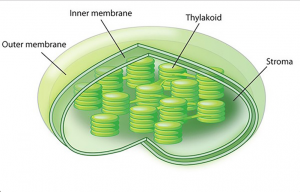
Energised
Chloroplast comes from the Greek translation chloros (green) and phyllon (leaf). Each tetraploid cell contains double the chloroplast of a diploid. The doubling of chromosomes and in particular chloroplast, produces robust plants with greater stress tolerance. Thylakoids inside the chloroplast contain the light-harvesting complex, including the chlorophyll green pigments essential to photosynthesis, absorbing sunlight in energy rich molecules. Photosynthesis converts the light energy into chemical energy, which is stored as carbohydrate and synthesized with water and carbon dioxide gas to produce energy for the plant. Oxygen is released as a waste product. In a nutshell, the increased cellular chloroplast benefits the plant by boosting chlorophyll production for energy absorption and processing. The outcome is a high energy, robust, hardwearing, healthier plant with improved stress tolerance and recovery capability, even in cooler temperatures.
Development
The first stage when creating a new tetraploid cultivar is different to the beginning of a new diploid. In place of the more usual clonal and poly-cross breeding, a current amenity diploid cultivar with the desired characteristics is selected for its characteristics and treated with the hormone. The treatment is applied to just a few grammes of seed in their initial stages of germination prior to emergence.
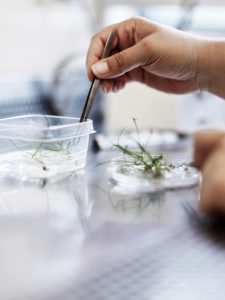
Chromosome counting in the laboratory
Following the treatment it’s back to business as usual to select only the best. Seed is multiplied in isolation to produce sufficient seed for further investigation. As with all new cultivars, the resultant progeny must conform to DUS protocols, that being distinct, uniform and stable, in order to achieve plant breeders variety rights and registration, a pre-condition for the certification of seed. To this end rigorous testing procedures are employed. Initially, young plants are grown under glass for observation and leaves and shoots have chromosome counts in the laboratory using flow cytometry, a laser based biophysical technology for cell counting. It may take a second or third generation of the new tetraploid offspring to produce both stability and viability for seed production. Several plants from the same parent are multiplied together in isolation. The resultant seed is harvested and used for field-testing in exactly the same way as diploids. Seeds are larger and high energy, around 500 seeds per gramme compared with 650-700 per gramme for sports diploids and up to 800 seeds per gramme for ultra dwarf super fine ryegrass. It’s at this stage where potential new cultivars are pushed to the limit and vital characteristics such as growth habit, wear, disease and drought tolerance, mowing height and visual merit are assessed. Only one or two will make it through this rigorous process from the many thousands at the beginning of the process.
Proven performance
Tetraploid perennial ryegrass provides a host of invaluable characteristics not found in diploids. High energy seed and growth in cooler conditions from 40C makes blends containing tetraploids such as R140 and R25 CRT perfect for transitional autumn overseeding and repairs. Superior winter-wear and robust re-growth helps keep surfaces in play though the winter high pressure period. Outcomes from the Rigby Taylor Sports Wear Trial at STRI concluded the balanced blend of tetraploid with top performing diploid perennial ryegrasses in R140 delivered superior winter wear performance compared with traditional diploid blends and mixtures.
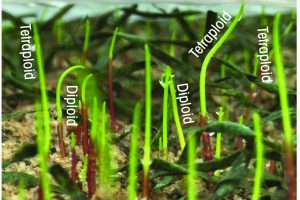
Tetraploid seedlings emerge faster than diploids
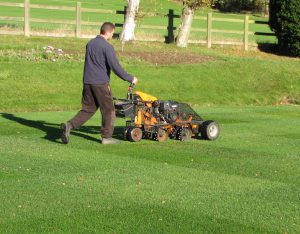
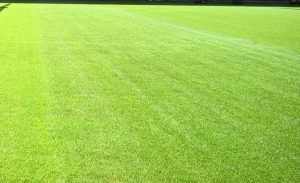
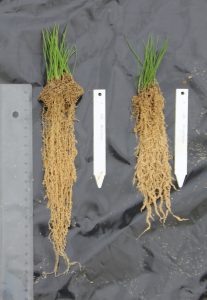
But tetraploids are not simply cool temperature performers; their high root mass also delivers greater drought tolerance and stability. Fast establishment is of particular benefit when renovation windows are short any time of year. Sports pitches, golf tees and fairways, cricket outfields, bowlers run-ups and walkways can all benefit from the speed of emergence and high root mass, helping restore the playing surface in the shortest possible time.
Doubling of the chloroplast enables tetraploids to harness as much light as possible, a useful characteristic when light levels are low during short winter days, in shade and on overcast days. A shade and wear trial at Les Alleuds Research Station shows how the latest tetraploid cultivars deliver great wear performance in reduced light levels of 60% PAR (photosynthetic active radiation).
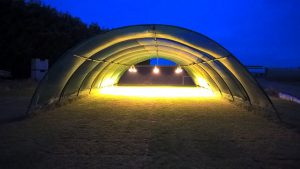
Light trials at the Les Alludes Research Station
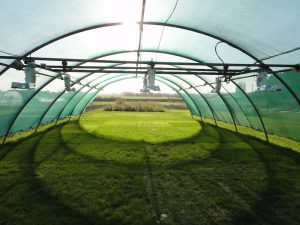
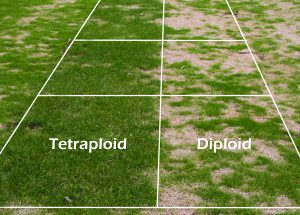
High disease pressure can be devastating to both the performance and visual aesthetics of the playing surface. Selecting cultivars with high disease tolerance is an important part of an integrated management approach and best practice. The official testing programme for the GEVES Turfgrass List hi-lights excellent tolerance of tetraploid cultivars to Microdochium Patch, Red Thread & Rust diseases
The future?
Although a relatively recent introduction to the amenity market, tetraploid mixtures and blends are fast becoming the number one choice for renovation and repair of natural and hybrid grass surfaces.
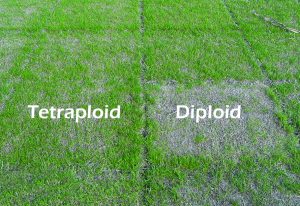
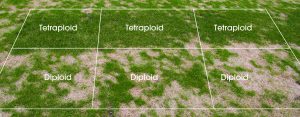
Blended with diploid ryegrasses or mixed with fescues they are reliable performers that always deliver. Their dramatic rise in popularity is entirely down to their proven performance in the field, which extends throughout the UK and globally at every level. International venues, Premiership to playing fields, racecourses flats and jumps, county and local cricket clubs, top 100 to pay and play golf courses and most recently selected as part of the grass seed line up for the FA Pitch Improvement Programme. Tetraploids really are becoming the go-to choice.
An extensive development programme at Top Green Research is to deliver new cultivars for the future.

























